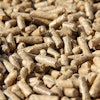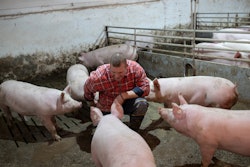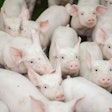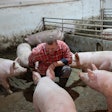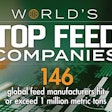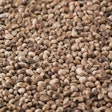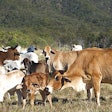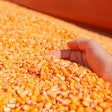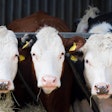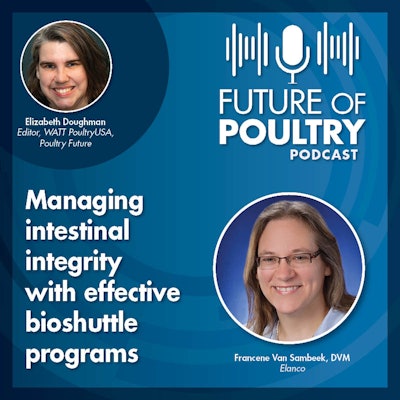
Elizabeth Doughman, editor, WATT PoultryUSA and Poultry Future: Hello, I’m Elizabeth Doughman, the editor of WATT PoultryUSA and Poultry Future.
This Future of Poultry podcast is brought to you by Elanco. Elanco Animal Health Incorporated is a global leader in animal health dedicated to innovating and delivering products and services to prevent and treat disease in farm animals and pets, creating value for farmers, pet owners, veterinarians, stakeholders and society as a whole.
With over 70 years of animal health heritage, Elanco is committed to helping their customers improve the health of animals in their care, while also making a meaningful impact on local and global communities. Elanco is driven by its vision of Food and Companionship Enriching Life and Elanco Healthy Purpose – all to advance the health of animals, people, the planet and enterprise. Learn more at www.elanco.com.
In today’s episode, my guest is Dr. Francene Van Sambeek, poultry technical consultant at Elanco.
Thanks for joining us today, Francene.
Can you explain the difference between a bioshuttle and a medicated starter in terms of an anticoccidial program?
Dr. Francene Van Sambeek, poultry technical consultant, Elanco: Sure, I’d be glad to. I will preface the question you just asked by saying that I'm only going to be addressing the no antibiotics important to human medicine or the NAIHM programs today. We can save the no antibiotics ever or the NAE programs for a later time.
A bioshuttle in a coccidial program utilizes a coccidial vaccine at the hatchery. Typically on day old chicks, and then that vaccine is allowed to cycle in the birds on the farm, typically up to about 16 to 18 days. Then for the bioshuttle, you put an anticoccidial product in the feed to help manage that coccidial peak cycling. This will decrease the amount of damage that occurs in the intestinal cells of the chicken. We like to call it dampening the cocci peak.
This type of program really supports gut health nutrient absorption while still allowing a controlled coccidial exposure and that allows the birds to develop immunity to this particular intestinal parasite.
The types of in-feed anticoccidial products that we generally use are ionophores or weak chemicals in a bioshuttle program. They're usually put in either in the second feed or potentially the second and third feeds really depending upon what your program calls for and what kind of control you're looking for. So that's a bioshuttle.
When we talk about another program where we use a medicated starter, we can build a very similar immunity without using that vaccine by putting the anticoccidial medication in the starter or what we typically consider the first feed that those chickens eat. I call this a straight anticoccidial program as we are not shuttling from one control program to another, like we do in a bioshuttle program, hence the name. By having anticoccidial drugs in the feed from the very start, we can reduce or sometimes even prevent coccidial infection outright, and it really provides a more immediate coccidial control to that bird.
The amount of control that we can get will depend on which type of anticoccidial product you choose. Products that can be used for either program, bioshuttle or a straight program, include ionophores, weak chemicals, and strong chemical anticoccidials. All of which have their own strengths and weaknesses. It really needs to be considered very carefully what you want to use.
The birds will still develop immunity to coccidiosis but with decreased intestinal damage if you have some kind of medicated product in the feed. Without this gut damage, the bird's much less likely to develop necrotic enteritis, which is a bacterial overgrowth in the intestines that can lead to some really high mortality if that's not controlled by antibiotics and management.
Doughman: How does the choice between a bioshuttle versus a medicated starter impact flock management, disease pressure and performance?
Van Sambeek: That's a really good question. Let's address the management part first.
Bioshuttle programs may require more careful monitoring of the vaccine uptake and the early bird health as we are relying solely on that bird's immune response to clear the vaccine, at least initially until the second feed, when the medicated products are introduced.
With in-feed medicated programs, the control program is with the birds in every mouthful, providing consistent protection. There are times when we will rotate the in-feed products to know prevent resistance buildup. Those strategies are best discussed with an Elanco technical consultant that's familiar with your specific needs and what your previous coccidiosis programs were.
Other management issues that we need to look at are the density of the bird placement in a poultry house. We want to maximize the number of birds in a house while still providing them with optimal growing conditions in which they can thrive.
In a vaccine only situation, the producers may choose to place less birds in a poultry house to decrease the disease pressures, but then there is an economic and sustainability cost to placing less birds in a house. In the end, it will require more poultry houses to raise same number of birds, which requires more construction costs and land use devoted to poultry rearing, and that will impact our sustainability and how we can manage future bird growth.
Regarding the disease pressure angle, as previously mentioned, necrotic enteritis is a major concern when using vaccines by themselves or what I call a naked vaccine program. Bioshuttles, which again medicate the second and/or second and third feeds, supports long-term immunity with a reduced fear of necrotic enteritis developing as we control the damage occurring in the intestine due to that vaccine cycling.
Medicated starters, because they're present from day one in the bird's life, really protect the intestinal integrity of the birds by providing a more immediate disease control, which can lead to improved growth, performance and productivity.
Doughman: What are some key factors in different production systems that influence your recommendations when choosing between interventions to maintain intestinal health in flocks?
Van Sambeek: Really good question, and I may get a little long-winded on this one because there's a lot of different things we really have to stop and consider. Just to preface again, today, I am really concentrating on the NAIHM programs rather than NAE.
When I look at intestinal health programs that I want to implement for that particular company, it's not going to be the same for everybody. It's going to depend on what is my current climate? What kind of management? Do I have any disease pressures from the past that might still be present in my poultry houses? Where is my final poultry product going to be sold? And then there are other factors. Let me address those issues. Let's do management first.
Management variables include things like the stocking density or how many birds are replacing in a poultry house. I go in and look at the litter quality, how is the ventilation? What is my water and feed quality? All of those variables play a part in the challenges that bird's going face in maintaining their intestinal integrity, and quite frankly, thriving in a modern poultry house.
What we discussed in the last question around sustainability that can also be impacted when we change management, like our stocking density or even the quality of the feed in terms of growth rates or how fast that bird can grow.
When I choose to use an in-feed medication for coccidia control, it really helps us manage the coccidia that's present through the feed on multiple producers houses where the management may vary considerably based on the age of the poultry house itself or if that housing has good litter and ventilation. Not every poultry grower has the same equipment or experience. Variation can certainly creep into our systems and lead to variation of how good our birds are going to grow. By choosing to medicate the feed, we try to reduce that variation and provide consistent product.
Looking at the climate angle, if I'm working with somebody that's in a hot and dry area, bioshuttles work well as the vaccines may be more effective where that environmental challenge is what I would call moderate.
Summertime is the peak time of year that I see bioshuttles utilized. That's when the vaccines typically get, get used. In a high challenge situation like humid and wet conditions, which quite frankly is usually experienced in wintertime, in-feed medications tend to provide me a more consistent and immediate control of coccidial issues.
Often, we say that our wintertime is our most challenging time of the year to grow chickens, and so that's where I'm going to target putting my best control program. I absolutely want to know what previous programs the producer has been on because I need to know how the rotation of products was accomplished. If I can have that information, I can look at how they, the birds performed on those previous programs and look at those previous results.
We do offer a service called HTSi or the Elanco Health Tracking System to monitor bird health and track how the birds responded to the different anticoccidial programs over time. What I love about this is it allows us to make data-driven decisions rather than just gut feelings on how I think that program did okay or that one I don't really care for. I'd rather have some data behind what my choices around anticoccidial products are based on.
I can give you another example. We recently were working with a company that had been on a naked vaccine program for a couple years. We did advise him to try our combination narasin-nicarbizin product called Maxiban, and use that in a straight program instead. We tracked them in our HTSi system. Over the next set of growouts, this company improved its FCR or feed conversion ratio by 10 points. To give you some math, with each point of feed conversion costing approximately $8,000 per week or even more if it's a big bird complex, when you start saving $8,000 a week, it can really start stacking up. It certainly did for this particular company. I love using HTSi as a monitoring tool for anticoccidial control.
Within that system, we also look at other health issues that might be impacting overall bird health. If I choose to do a bursal survey to explore infectious bursal disease virus, because that can create immune problems in our birds. That's something we've been dealing with for decades. The poultry industry has known about that one for a long time.
We also get new things that come into our health system, like the aMPV or avian metapneumovirus. It's a very recent virus impacting the U.S. poultry market, and we need to know how to deal with that issue. We do track that one in our system.
Finally, I think looking at where your final product distribution goes. And it really depends on which company or even which country you shipped your finished poultry product to. That may limit what products you can use in the feed. Here at Elanco, we are certainly glad to assist you in each of the areas I talked about in order to make the best strategic anticoccidial program for your production system.
Doughman: What is the most effective way to integrate a vaccine into a coccidiosis management program?
Van Sambeek: I would say time of the year that you want to implement is super critical. Summertime is the good time to do this kind of a vaccine introduction as we can typically manage the house conditions better during those hot dry periods than during the cold, wet times of year. Certainly if we do a bioshuttle where we utilize a medicated second feed, we can deliver that vaccine at the optimal stage and then control that cycling to maximize performance for our birds.
We're going to look at how can we use best practices in terms of management, which I previously described, such as maintaining litter quality, water quality and feed consistency in order to really optimize the intestinal integrity of that bird and get the best performance out of them that we can.
I am going to monitor how those birds are doing in terms of us looking at the growth rate and flock health. We certainly want our poultry producers to have the best experience on those products and we want those birds to also develop proper immunity to the coccidial vaccine that we're trying to do.
We use HTSi to monitor for that. Elanco representatives are good at the HTSi systems, but we also are available to go into poultry houses and look at the management variables themselves and see how those birds are dealing in that particular situation. If we see an issue, we can certainly make recommendations on how to resolve that issue early before the problem really becomes overwhelming and blows up in that chicken house. I think that's some of the ways we can help you integrate vaccine into an anticoccidial program.
Doughman: For anyone that needs additional support on integrating a vaccine into a coccidiosis management program, how can they access resources?
Van Sambeek: I myself am a technical consultant with Elanco and I love to help people tailor either an effective bioshuttle program or a straight anticoccidial program. I love to look at how we can put some best practices in place around how we're managing feed.
I would actually encourage our listeners to reach out to us at Elanco for help and advice that we can give them as technical consultants and product recommendations, and we are more than happy to be here of a service to our poultry producers.
Doughman: Thanks again, Francene, and thanks to you for tuning in. For more information on the solutions discussed here today, visit Elanco at www.elanco.com.
For more episodes of the Future of Poultry podcasts, please like and subscribe on WATTPoultry.com or wherever you access podcasts.


